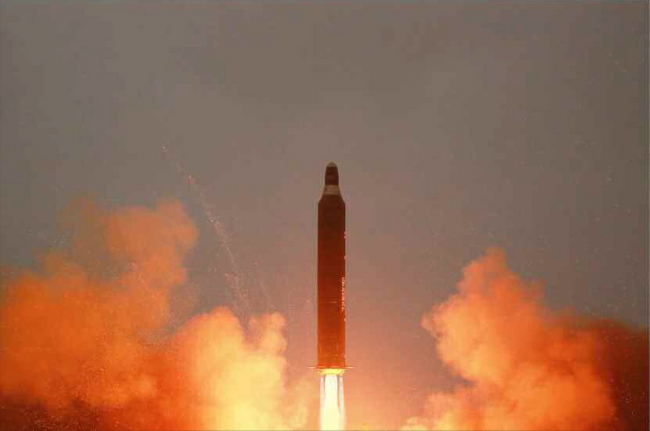North Korea launched an intermediate ballistic missile off its east coast Sunday, marking its first provocation since US President Donald Trump took office, South Korea’s military officials said.
The missile lifted off at 7:55 a.m. from Banghyeon, North Pyongan Province, a town from which the regime previously fired an intermediate-range Musudan missile in October. Having reached an altitude of 550 kilometers, it flew about 500 kilometers before falling into the East Sea, according to Seoul’s Joint Chiefs of Staff.
The military here said the missile was probably a variant of the 3,000-kilometer-range Musudan missile that uses solid fuel, not liquid as is often used in the missile. The technology could improve the ability to conceal the weapon, it added.
The missile lifted off at 7:55 a.m. from Banghyeon, North Pyongan Province, a town from which the regime previously fired an intermediate-range Musudan missile in October. Having reached an altitude of 550 kilometers, it flew about 500 kilometers before falling into the East Sea, according to Seoul’s Joint Chiefs of Staff.
The military here said the missile was probably a variant of the 3,000-kilometer-range Musudan missile that uses solid fuel, not liquid as is often used in the missile. The technology could improve the ability to conceal the weapon, it added.

“We don’t rule out the possibility that the North can might use new technology,” said a JCS official on customary condition of anonymity, adding that further analysis is needed to confirm whether the test was successful.
North Korea attempted 24 missile launches and two nuclear tests in 2016, including eight launches of the Musudan missile that can be fired from concealed road-mobile vehicles. But the most recent attempt to launch a Musudan in October failed.
Seoul, Washington and Tokyo condemned the launch as a “flagrant and clear” violation of UN Security Council resolutions that ban Pyongyang from pursuing ballistic missile technology because it could be used to deliver nuclear warheads. The regime conducted its fifth nuclear test in September.
The official said the military views the test as “a show of force” in response to hard-line positions adopted by the new US administration, which has reportedly launched a policy review on North Korea amid the concerns that North Korea could strike the US with a nuclear-tipped ballistic missile.
But the official downplayed the possibility the missile was an intercontinental ballistic missile, citing its different flight pattern. Recently, North Korea claimed to be in a “final phase” of developing ICBMs and threatened to fire it “anytime and anyplace.”
The US Strategic Command also confirmed the latest launch, saying the projectile is believed to be either a medium- or intermediate-range missile and that the launch occurred near the northwestern city of Kusong, a county nearby the Banghyeon military site.
“US Strategic Command systems detected and tracked what we assess was a North Korean missile launch at 4:55 p.m. CST,” spokesman Lt. Col. Martin O‘Donnell said, adding that the US would remain vigilant in the face of North Korean provocations and is fully committed to working closely with its allies.
Shortly after liftoff, Cheong Wa Dae convened a National Security Council meeting chaired by its chief Kim Kwan-jin. Acting President Hwang Kyo-ahn also said that the government is working with the international community to seek measures commensurate with Pyongyang’s act.
Kim called US counterpart Michael Flynn and reached an agreement to cooperate in seeking ways to deter provocation by the North, said the presidential office. Seoul’s top nuclear negotiator, Kim Hong-kyun, also spoke by phone with his US and Japanese counterparts, respectively.
“(The missile launch) showed the irrationality of Kim Jong-un regime, which has been obsessed with nuclear and ballistic missiles,” said South Korea’s Foreign Ministry in a statement. “We will ensure that the North realizes that it cannot survive without abandoning its nuclear and missile programs.”
The UN Security Council unanimously passed a fresh resolution in late November that aims to tighten economic sanctions on Pyongyang, including cutting the country’s coal exports, after the regime conducted its fifth nuclear test in September.
The missile launch came less than two days after Trump’s first summit as president with Japan’s Prime Minister Shinzo Abe in Washington, during which Trump called the North’s nuclear and missile threats a “very high priority.”
Following the test, the two leaders held an impromptu news conference in Florida on Sunday, with Abe lambasting the launch as “absolutely intolerable” and Trump pledging the US’ “100 percent” commitment to its allies.
Cheong Seong-jang, senior fellow at the Sejong Institute, said Pyongyang’s missile capability is reaching a “stable level,” noting the range of the missile fired Sunday was greater than an intermediate-range Musudan missile that the North had fired last year.
“They appeared to be successful in their first launch of an intermediate-range missile this year,” said Cheong. “Not only do they need to develop their missile capability, they also want to show their determination not to give into the pressure from Trump administration.”
By Yeo Jun-suk (jasonyeo@heraldcorp.com)




![[Herald Interview] 'Amid aging population, Korea to invite more young professionals from overseas'](http://res.heraldm.com/phpwas/restmb_idxmake.php?idx=644&simg=/content/image/2024/04/24/20240424050844_0.jpg&u=20240424200058)











![[KH Explains] Korean shipbuilding stocks rally: Real growth or bubble?](http://res.heraldm.com/phpwas/restmb_idxmake.php?idx=652&simg=/content/image/2024/04/25/20240425050656_0.jpg&u=)

